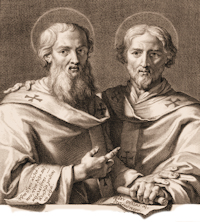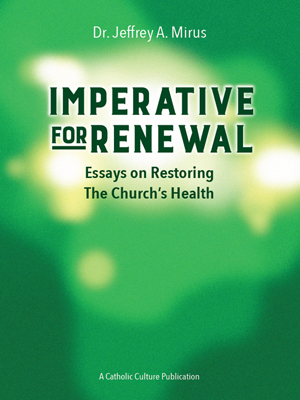Christmas: January 2nd
Memorial of St. Basil the Great and St. Gregory Nazianzen, Bishops and Doctors
Other Commemorations: St. Telesphorus, Pope and Martyr (RM)
» Enjoy our Liturgical Seasons series of e-books!
Today the Church celebrates the Memorial of St. Basil the Great (329-379) and St. Gregory Nazianzen (330-390), bishops and doctors. This is the Ninth Day of the Christmas season.
St. Basil was a brilliant student born of a Christian family in Caesarea, Cappadocia (Turkey). For some years, he followed the monastic way of life. He vigorously fought the Arian heresy. He became Bishop of Caesarea in 370. The monks of the Eastern Church today still follow the monastic rules which he set down.
St. Gregory was also from Cappadocia. A friend of Basil, he too followed the monastic way of life for some years. He was ordained priest and in 381 became Bishop of Constantinople. It was during this period when the Arian heresy was at its height. He was called "The Theologian" because of his great learning and talent for oratory.
The Roman Martyrology today commemorates of St. Telesphorus, Pope and Martyr (d. 138). According to St. Irenaeus, St. Telesphorus, who governed the Church from 128 to 138 during a period of violent persecution, suffered martyrdom for the faith.
St. Basil the Great and St. Gregory Nazianzen—Day Nine
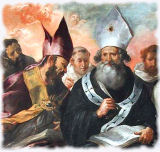 Although New Year's Day is not celebrated by the Church, this day has been observed as a holy day of obligation since early times due to the Solemnity of Mary, Mother of God. Each family and country has different traditional foods to eat on New Year's Day, with lentils being the main superstition: ill luck befalling those who do not eat lentils at the beginning of the year.
Although New Year's Day is not celebrated by the Church, this day has been observed as a holy day of obligation since early times due to the Solemnity of Mary, Mother of God. Each family and country has different traditional foods to eat on New Year's Day, with lentils being the main superstition: ill luck befalling those who do not eat lentils at the beginning of the year.
New Year's is a day of traditional hospitality, visiting and good cheer, mostly with a secular view, but there is no reason that this day, too, could not be sanctified in Christ.
- Day Nine Activity (Blessing of the Bread of St. Basil)
- Day Nine Recipe (St. Basil's Day Bread)
St. Basil the Great
St. Basil was born about 330, the oldest of four sons; three of his brothers became bishops, one of whom was St. Gregory of Nyssa. His pious grandmother Macrina exercised a great influence upon his religious education: "Never shall I forget the deep impression that the words and example of this venerable woman made upon my soul." Between St. Basil and St. Gregory of Nazianzen an intimate friendship existed from youth to old age. Of Western monasticism St. Benedict was the father and founder, of Eastern monasticism, St. Basil.
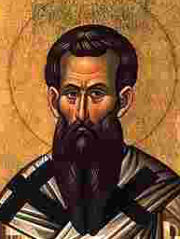 As bishop, Basil was a courageous and heroic champion of the Catholic faith against the Arian heresy. In 372 Emperor Valens sent Modestus, the prefect, to Cappadocia to introduce Arianism as the state religion. Modestus approached the holy bishop, upbraided him for his teaching, and threatened despoliation, exile, martyrdom, and death. To these words of the Byzantine despot, Basil replied with the peace of divine faith: "Is that all? Nothing of what you mentioned touches me. We possess nothing, we can be robbed of nothing. Exile will be impossible, since everywhere on God's earth I am at home. Torments cannot afflict me, for I have no body. And death is welcome, for it will bring me more quickly to God. To a great extent I am already dead; for a long time I have been hastening to the grave." Astonished, the prefect remarked: "Till today no one has ever spoken to me so courageously." "Perhaps," rejoined Basil, "you have never before met a bishop." Modestus hastened back to Valens. "Emperor," he said, "we are bested by this leader of the Church. He is too strong for threats, too firm for words, too clever for persuasion."
As bishop, Basil was a courageous and heroic champion of the Catholic faith against the Arian heresy. In 372 Emperor Valens sent Modestus, the prefect, to Cappadocia to introduce Arianism as the state religion. Modestus approached the holy bishop, upbraided him for his teaching, and threatened despoliation, exile, martyrdom, and death. To these words of the Byzantine despot, Basil replied with the peace of divine faith: "Is that all? Nothing of what you mentioned touches me. We possess nothing, we can be robbed of nothing. Exile will be impossible, since everywhere on God's earth I am at home. Torments cannot afflict me, for I have no body. And death is welcome, for it will bring me more quickly to God. To a great extent I am already dead; for a long time I have been hastening to the grave." Astonished, the prefect remarked: "Till today no one has ever spoken to me so courageously." "Perhaps," rejoined Basil, "you have never before met a bishop." Modestus hastened back to Valens. "Emperor," he said, "we are bested by this leader of the Church. He is too strong for threats, too firm for words, too clever for persuasion."
Basil was a strong character, a burning lamp during his time. But as the fire from this lamp illumined and warmed the world, it consumed itself; as the saint's spiritual stature grew, his body wasted away, and at the early age of forty-nine his appearance was that of an old man. In every phase of ecclesiastical activity he showed superior talent and zeal. He was a great theologian, a powerful preacher, a gifted writer, the author of two rules for monastic life, a reformer of the Oriental liturgy. He died in 379, hardly forty-nine years old, yet so emaciated that only skin and bones remained, as though he had stayed alive in soul alone.
Patronage: hospital administrators; monks; reformers; Cappadocia; Russia; Cessaniti, Italy
Symbols and Representation: Supernatural fire, often with a dove present; carrying a scroll or book, referring to his influential writings
Highlights and Things to Do:
- Listen to the Catholic Culture Audiobook: St. Basil the Great—On the Right Use of Greek Literature read by James Majesksi.
- Read more about St. Basil:
- See St. Basil's Sermons about Fasting.
- See the collection of St. Basil's writings or Catholic Culture's collection of Church Fathers' writings, including Basil and Gregory.
- Catholic Cuisine has some clever recipes for St. Basil.
- St. Basil is claimed both by the Eastern and Western churches, including the Orthodox. His relics are distributed far and wide, but mainly in Orthodox settings.
St. Gregory Nazianzen
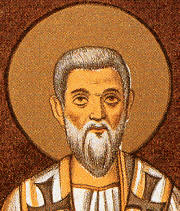 Gregory, surnamed the "Theologian" by the Greeks, was born at Nazianz in Cappadocia in 339. He was one of the "Three Lights of the Church from Cappadocia." To his mother, St. Nonna, is due the foundation for his saintly life as an adult. He was educated at the most famous schools of his time - Caesarea, Alexandria, Athens. At Athens he formed that storied bond of friendship with St. Basil which was still flaming with all the fervor of youthful enthusiasm when he delivered the funeral oration at the grave of his friend in 381.
Gregory, surnamed the "Theologian" by the Greeks, was born at Nazianz in Cappadocia in 339. He was one of the "Three Lights of the Church from Cappadocia." To his mother, St. Nonna, is due the foundation for his saintly life as an adult. He was educated at the most famous schools of his time - Caesarea, Alexandria, Athens. At Athens he formed that storied bond of friendship with St. Basil which was still flaming with all the fervor of youthful enthusiasm when he delivered the funeral oration at the grave of his friend in 381.
Gregory was baptized in 360, and for a while lived the quiet life of a hermit. In 372 he was consecrated bishop by St. Basil. At the urgent wish of Gregory, his father and bishop of Nazianz, he assisted him in the care of souls. In 381 he accepted the see of Constantinople, but grieved by the constant controversies retired again to the quiet life he cherished so highly and dedicated himself entirely to contemplation.
During his life span the pendulum was continually swinging back and forth between contemplation and the active ministry. He longed for solitude, but the exigencies of the times called him repeatedly to do pastoral work and to participate in the ecclesiastical movements of the day. He was unquestionably one of the greatest orators of Christian antiquity; his many and great accomplishments were due in great measure to his exceptional eloquence. His writings have merited for him the title of "Doctor of the Church."
—Excerpted from The Church's Year of Grace, Pius Parsch
Patronage: for harvests; poets
Symbols and Representation: bishop with a book, codex or scroll; censer; man writing with dove nearby;
man writing with the hand of God over him; iconographically, he is depicted as balding with a bushy white beard.
Highlights and Things to Do:
- We too must harmoniously combine the two phases of spiritual life, the contemplative which tends to solitude and the active or pastoral which responds to the need of the times and the good of souls.
- See the collection of St. Gregory's writings here or Catholic Culture's collection of Church Fathers' writings, including Basil and Gregory or CCEL.
- Read more about St. Gregory:
- Read Basil, Gregory and the Holy Spirit
- See the statue of St. Gregory in St. Peter's Basilica Colonnade.
- St. Gregory Nazianzen's relics are mainly in Istanbul in the Patriarchal Cathedral of St. George in the Fanar, with some small relics in St. Peter's Basilica in Rome. See this site for further details. In 2004, Pope St. John Paul II transferred the main relics back to Istanbul.
St. Telesphorus
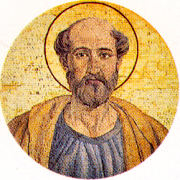 St. Telesphorus was Greek, probably from Calabria. He is considered the eighth pope in succession of St. Peter, reigning from 127 or 128-137 or 138 A.D.. The Liber Pontificalis (Book of the Popes) mentions he was living as a hermit (monk or anchorite) before election as pope, often thought to be living on Mount Carmel. Because of that location, the Carmelite order has often claimed him, and he is often depicted in the Carmelite habit.
St. Telesphorus was Greek, probably from Calabria. He is considered the eighth pope in succession of St. Peter, reigning from 127 or 128-137 or 138 A.D.. The Liber Pontificalis (Book of the Popes) mentions he was living as a hermit (monk or anchorite) before election as pope, often thought to be living on Mount Carmel. Because of that location, the Carmelite order has often claimed him, and he is often depicted in the Carmelite habit.
It is often thought that he instituted the tradition of keeping a seven-week Lenten season, the three Masses for Christmas and also singing the Gloria, but this is often disputed.
He established the tradition that Easter should be celebrated on Sunday, rather than other days of the week like the Jewish Passover tradition. However, he maintained fellowship with communities that did not celebrate Easter on Sunday. According to St. Irenaeus, he was "an illustrious martyr." His remains are interred in the Vatican.
Symbols and Representation: Pope with a chalice over which three Hosts hover (may refer to the celebration of Christmas with 3 Masses said to represent the temporal, spiritual, and eternal birth of Christ); pope with a chalice with a nearby club (possibly an indication of his martyrdom).
Highlights and Things to Do:
- Read more about St. Telesphorus:
- Pope Telesphorus' relics are in St. Peter's Basilica, but his tomb is unknown. Originally around Saint Peter's tomb the following popes were traditionally believed to have been buried: Pope Linus (2), Pope Anacletus (3), Pope Evaristus (5), Pope Telesphorus (8), Pope Hyginus (9), Pope Pius I (10), Pope Anicetus (11) (later transferred to the Catacomb of Callixtus), and Pope Victor I (14).
- See Pope Telesphorus' decree in Latin A Decree on The Fast of Seven Weeks before The Passover.


